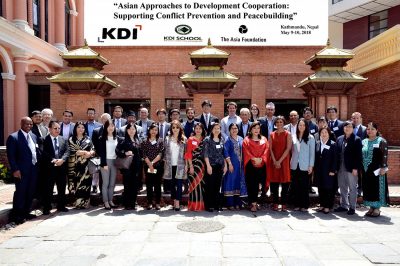InAsia
Insights and Analysis
Seven Takeaways on Asian Approaches to Conflict Prevention and Peacebuilding
June 20, 2018
Despite rapid economic growth, conflict has persisted in many parts of Asia. Half of the countries in South and Southeast Asia have experienced subnational conflicts in recent decades. Many face the challenge of managing tensions between diverse ethnic and religious communities. Local conflicts associated with land, natural resources, and urban crime have also arisen as Asian countries have developed and urbanized. Protracted conflicts in the region have hindered development and growth, nationally and regionally.
While conflict, peacebuilding, and development is not a new area of development cooperation, many lessons from past international efforts have little applicability in Asia. These efforts have often focused on the role that Western nations or multilateral bodies can play in supporting statebuilding to build peace. Yet many conflicts in Asia have occurred in countries with capable, functioning states. Middle-income countries such as Indonesia, Thailand, and the Philippines have all experienced internal conflicts. On the other hand, there has been little analysis of the intersection between Asian South-South cooperation and conflict prevention or peacebuilding programs.

A group of Maoist rebels in the Rolpa district, Nepal, during the recent civil war
South-South cooperation emphasizes supporting peacebuilding efforts in partner countries by drawing on a country’s own relevant experience. Countries such as India, China, Malaysia, Korea, Japan, and Indonesia are increasingly supporting peacebuilding in other Asian countries—by facilitating peace talks, sharing insights from conflicts in their own countries, and supporting economic or cultural programs. As these efforts multiply, the lessons learned from South-South peacebuilding cooperation deserve greater attention. The State of Violence and Conflict in Asia, recently released by The Asia Foundation, identifies country-to-country learning as a critical need for peacebuilding in Asia.
On May 9 and 10, peace and conflict specialists from government, academia, think tanks, NGOs, and multilateral organizations across Asia gathered in Kathmandu, Nepal, to discuss the characteristics, modalities, and effectiveness of Asian peacebuilding support. This 18th meeting of the Asian Approaches to Development Cooperation (AADC) dialogue was jointly organized by The Asia Foundation, the Korea Development Institute (KDI) and the KDI School of Public Policy and Management.(Read more about the ongoing AADC dialogue.)

AADC Conference, May 2018
Here are key takeaways:
- Given the scale of Asian-led economic cooperation, particularly in infrastructure, Asian providers should apply conflict-sensitivity frameworks to their investments. Economic growth can often create tensions due to land acquisition, resource extraction, or poor community consultation. Long-term investments in governance and the rule of law are also needed to ensure that economic development leads to peace and does not make fragile situations worse. This is particularly relevant to China, India, and Japan as they expand their connectivity and infrastructure initiatives across Asia.
- Asian experiences of the transition from conflict to peace can be more relevant to neighboring countries than global expertise. For example, Indonesia prioritizes peacebuilding in its South-South activities and draws on its own experience of managing conflict and building peace in Aceh, Poso, Ambon, and Borneo to advise and support countries such as Myanmar, Cambodia, and Afghanistan.
- In countries like Afghanistan where there is a high level of violence, conflict prevention and peacebuilding may need to wait until the security situation is under control. Constant terrorist attacks thwart efforts to build institutions of peace and divert resources from development.
- Nonstate Asian actors such as CSOs and religious organizations have played a significant role in Asia-Asia peacebuilding. In South Korea’s engagement policy towards North Korea, for example, humanitarian CSOs had a significant influence in mitigating conflict on the peninsula and increasing openness between the South and the North.
- Regional economic projects can build political bridges in conflict situations and provide opportunities for the region’s dominant powers to work together. For example, supporting Afghanistan’s regional connectivity offers a win-win for rivals India and Pakistan by unleashing shared potential for bilateral and multilateral trade and investment.
- Community mediation is an increasingly common strategy to address tensions caused by urbanization, humanitarian crises, scarce resources, resettlement, etc. In Nepal, for example, community mediation flourished during and after the civil war, evolving in sophistication to handle a variety of disputes including complex, multi-stakeholder conflicts over natural resources, postdisaster rehabilitation, the distribution of relief aid, and identity-based discrimination and social injustice. The ready accessibility and adaptability of alternative dispute-resolution mechanisms at the local level has added to its popularity. The Nepal Mediation Act, aimed at improving judicial governance in the country, was enacted in 2014. AADC participants visited a mediation center in Kavre, a district with both postconflict and postearthquake issues. The center hosts 851 mediators and has mediated over 1,500 disputes annually, with a resolution rate greater than 90 percent.
- Neighbors matter. The laws and policies of neighboring countries can influence a country’s conflict dynamics. Asian countries should examine how their own policies, particularly border regulations, may aggravate or mitigate neighboring conflicts. In Myanmar, border areas near Thailand and China are strategic launching pads and sanctuaries for rebel groups, which take advantage of cross-border arms and resource trading. Thailand and China both initially followed a buffer policy, supporting sympathetic rebel groups. Thailand halted support in the 1990s and began cracking down on weapons smuggling and restricting illegal exports of natural resources, weakening rebel forces. China, on the contrary, has not. As a result, Myanmar has achieved some stability along the Thai border through better regulation and a nationwide ceasefire agreement, but this has not been the case along its northern, Chinese border.
Economic growth and infrastructure investment are transforming Asia, but the benefits of this development are often stalled by failure to address conflict dynamics. The AADC dialogue showed that Asian countries with extensive experience managing and mitigating conflict in their own territories can apply these lessons in their bilateral partnerships. As Asian South-South cooperation continues to expand, more research and evaluation are needed to determine how this cooperation can encourage peacebuilding rather than fuel conflict.
Anthea Mulakala is The Asia Foundation’s director for international development cooperation, and Binayak Basnyat is a program associate in the Foundation’s office in Nepal. They can be reached at [email protected] and [email protected], respectively. The views and opinions expressed here are those of the authors and not those of The Asia Foundation.
About our blog, InAsia
InAsia is posted and distributed every other Wednesday evening, Pacific Time. If you have any questions, please send an email to [email protected].
Contact
For questions about InAsia, or for our cross-post and re-use policy, please send an email to [email protected].The Asia Foundation
465 California St., 9th Floor
San Francisco, CA 94104
The Latest Across Asia
Program Snapshot
April 18, 2024
News
April 17, 2024

2024 Lotus Leadership Awards
Thursday, April 25, 2024, New York City
The Lotus Leadership Awards recognize contributions towards gender equality in Asia and the Pacific







0 Comments